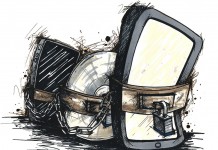
From the press release. I should note that Book Industry Study Group surveys are pretty rigorous in their methedology:
E-book consumers’ preference for tablets is accelerating rapidly as dedicated e-readers drop in popularity, according to the Book Industry Study Group (BISG)’s closely watched survey. The second installment in Volume Three of the study shows that, over the course of just six months, consumers’ ‘first choice’ preference for dedicated e-readers such as those from Amazon and Barnes & Noble declined from 72 percent to 58 percent. Tablet devices are now the most preferred reading device for more than 24 percent of e-book buyers, up from less than 13 percent in August 2011. Further, the increase in tablet preference was not primarily for Apple’s iPad (which rose by just over one percent), but for non-Apple tablets — overwhelmingly from Amazon and Barnes & Noble. These non-Apple devices increased from five percent to 14 percent over the same period.
‘The movement from dedicated e-readers to multi-function tablet devices is an important one for publishers to understand, as it allows them to deliver a richer, more interactive e-book experience,’ said Angela Bole, BISG’s Deputy Executive Director. ‘One of the strengths of this study is that it can plot such evolution, preparing publishers for what e-book readers want and expect from them next.’
The study, powered by Bowker Market Research, points to a buoyant book market. Nearly 30 percent of respondents in the February 2012 survey reported an increase in dollars spent on books in all formats since they began acquiring e-books, while nearly 50 percent reported an overall increase in the volume of titles purchased in any format. The numbers are even rosier for the e-book market: more than 62 percent of respondents reported an increase in dollars spent on e-books, and more than 72 percent said they have increased the volume of e-titles they are buying. Some publishers are reporting that even when overall revenue has declined, profitability — particularly for e-books — has increased.
In addition to ‘Power Buyers’ (those who acquire e-books at least weekly), this report looks at the behavior of ‘Casual Buyers,’ who purchase one or two books a month. The study reveals that this second generation of e-book and e-reader adopters is catching up with Power Buyers in a number of ways. More than 27 percent of Casual Buyers now exclusively purchase e-books rather than print, compared to 30 percent of Power Buyers. Further, Casual Buyers are only slightly more likely to play games (37 percent vs. 35 percent) or watch video content (23 percent vs. 21 percent) on their devices. However, Casual Buyers lag significantly behind Power Buyers on the uptake of multi-function devices. Only half of Casual Buyers use a tablet regularly, compared to 83 percent of Power Buyers. “


































I doubt they’re getting tablets for ebooks with a “rich interactive experience.” Those are few, will always be few (due to high costs), and are often badly done. Pundits have been saying those sorts of things since CD-ROMs in the late eighties and it never happens. With a few exceptions (i.e. travel guides) other medias doesn’t mix well with text.
What they are getting tablets for are the impressive collection of apps that let them do other things from web browsing and email to whatever interests the most. Sky Walk on my iPad, for instance, lets me sky watch for Seattle, where the visible stars are few.
Michael – I agree fully. This is the usual ‘survey’ of self selecting and subjectively questioned targets followed by the usual excessive interpretation.
I don’t believe anyone is buying tablets for reading eBooks an especially not to experience a richer, more interactive e-book experience … for goodness sakes when I read a normal piece of fiction, a novel, I don’t want any KIND of richer, more interactive e-book experience and I am sure that apples to most people. I also think people should note that this is not a zero sum game. Both markets are growing and will continue to grow. Therefore the relative percentages have to be interpreted in a completely different way imho.
Tablets are multifunctional devices and one of those functions is reading eBooks. End of story. People who want to use multiple functions will go for tablets.
Others who want a dedicated device that is simpler, lighter and cheaper will continue to go for dedicated eReaders. I am convinced there will continue to be a significant market for both.
I know some people genuinely prefer reading on their tablets. I still believe those are in the minority however. E-books completely notwithstanding, more and more people are getting tablets, and one of the things tablets provide is the ability to buy/download and e-book. That is perfect for the casual/occasional readers who probably didn’t want to buy an e-reader, but now have one regardless. Lots of pundits seem in a hurry to decalre the death of E-ink technology. I think that’s very premature. E-ink as we know it is far from perfect, but it serves it’s niche very well, and the tech to replace it hasn’t been invented yet. (No, I’m sorry, even the new Apple displays don’t even come close.) As more tablet owners start aquiring larger e-book libraries, I think this will actually help grow the market for dedicatd e-ink readers.
90% of people who only own a tablet prefer reading on their tablet! You gotta love surveys.
In other news, 90% of the people waiting in the drive through line at Jack In The Box would prefer to eat a Burger! Therefore, burgers are the best food.
rashkae – of course they prefer reading on their tablets. Reading on tablets is a very good experience. I actually have been reading on a kindle and an iPhone for a year or more and I have drifted back away from the Kindle to the iPhone in recent weeks because the page transitions on the kindle have become quite irritating for me. I just like the way the pages turn and slide sideways off the page on my iPhone compared with the Kindle ‘flash’ style.
>Ebook consumers preference for tablets is accelerating rapidly
Not a surprise for me, ’cause it’s the same thing I’m experiencing. But it’s not of the more possibilities a tablet might offer but because the software provided at dedicated ebook-readers is not sufficient. It’s not an exception to have more than 100 (e)books if you’re a reader. And since ebooks don’t need much space it’s a normal process to keep them all at the ereader as well. But every device I tested so long doesn’t provide a software that can handle that amount of books.
– Either they need much to long to load the sd-card or hang up on it,
– or they don’t show the metadata like the book description or even the genre,
– or they only show the first genre entry – multiple fields occurances are being ignored,
– or you can only search over title and author and not over genre or description and so on …
And those requirements are getting important for me at a much smaller amount than 100 books at my reader. So I’m looking for my next ereader to be a tablet with android because I know I can than atleast install aldiko which covers most of my requirements.
Today I went to a McDonalds with a Kindle 3. I went with someone who had a Nook Color. We sat at a table next to a window. The light coming from outside made the NC a pain to read compared to the Kindle.
Unless someone reads mainly in the dark I don’t know anyone would prefer a tablet for books. I am sure tablets will outsell e-ink devices because games and videos are more popular than books.
At font size #4 on an e-ink Kindle, Robert Caro’s Master of the Senate is extremely annoying with too much space between lines. Thus, I am reading that one on my iPad where it looks completely normal. However, where I prefer to read at any given time generally depends on the amount of light available. When there is plenty of light, I prefer the e-ink screen. At night in a dimly lit bedroom, it’s the iPad. Maybe all those tablet readers spend their time in dim light.
I own a Kindle DX and a Kindle Fire. I adore my KDX, and after about 15 minutes of trying to read an ebook on my Fire, I gave up. I use the two gadgets for different things, and hope that Amazon keeps producing e-ink readers for a long time because whenever I have to replace my KDX I want another one!
Mercer – I have happily read my iPhone and an iPad in a very sunny environment without any problem. I don’t see your problem. Even if there is a direct sunlight issue I have switched to white on black and the issue is instantly solved.